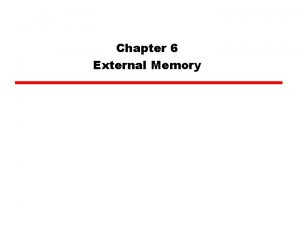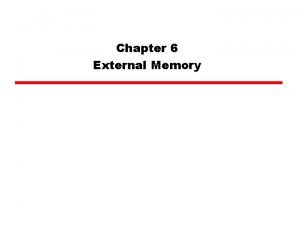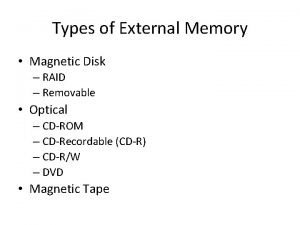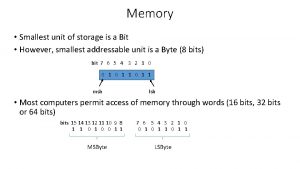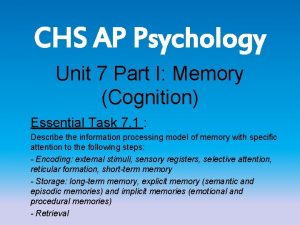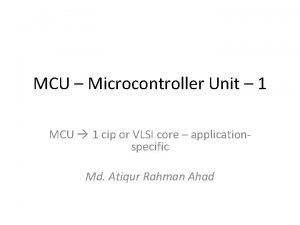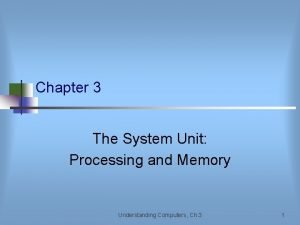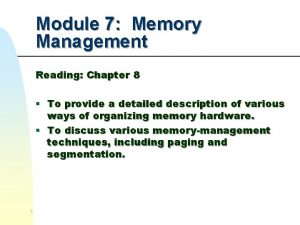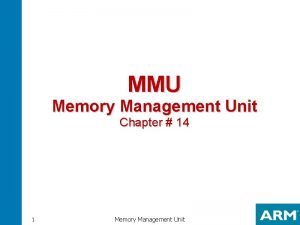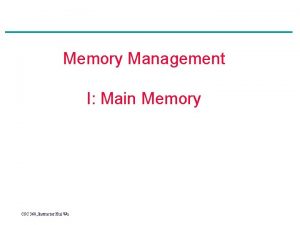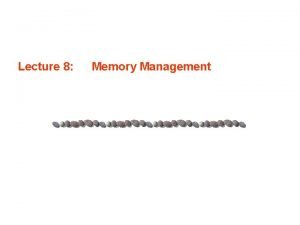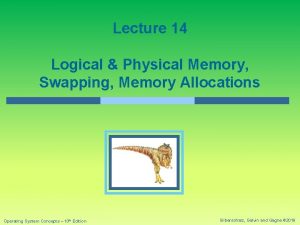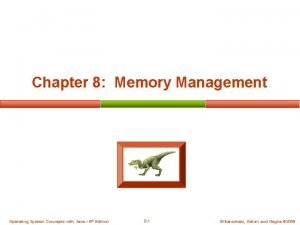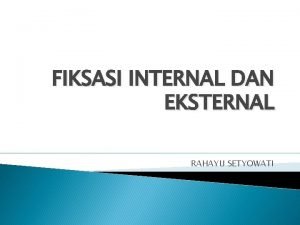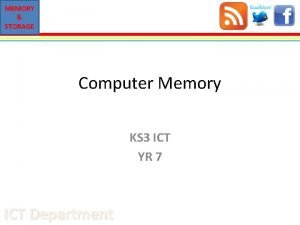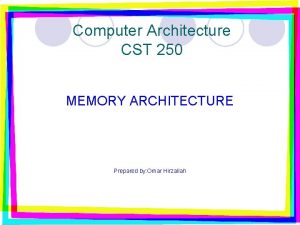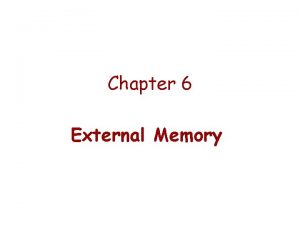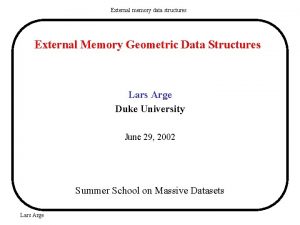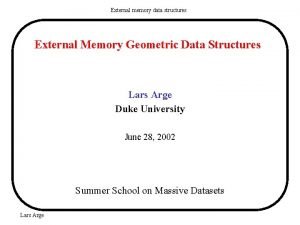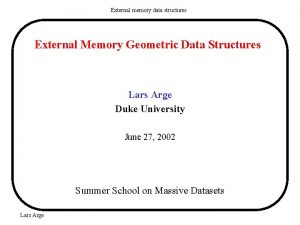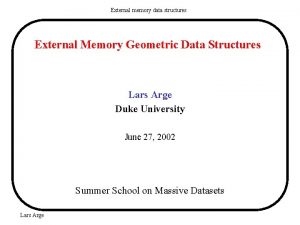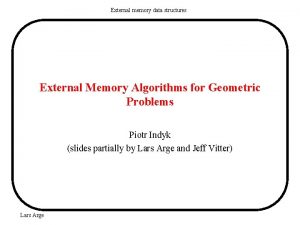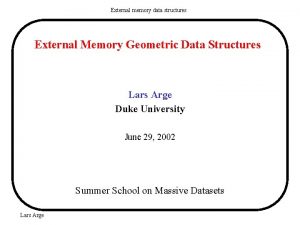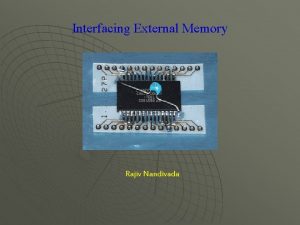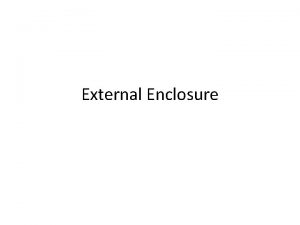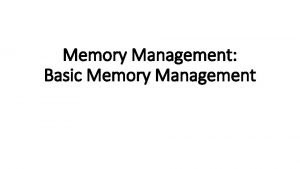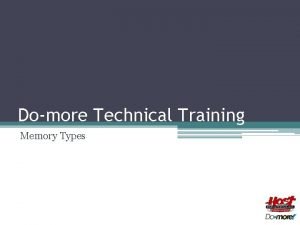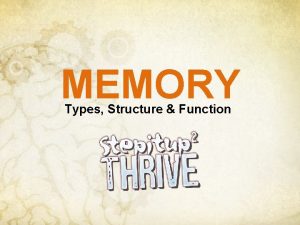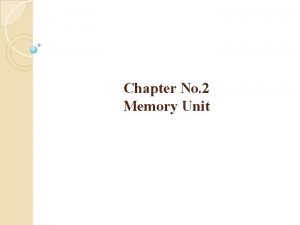Unit 2 Chapter 6 External Memory Types of



































- Slides: 35

Unit- 2 Chapter 6 External Memory

Types of External Memory • Magnetic Disk —Removable • RAID

Magnetic Disk • Disk substrate coated with magnetizable material (iron oxide…rust) • Substrate used to be aluminium • Now glass —Improved surface uniformity – Increases reliability —Reduction in surface defects – Reduced read/write errors —Lower flight heights (See later) —Better stiffness —Better shock/damage resistance

Read and Write Mechanisms • • Recording & retrieval via conductive coil called a head May be single read/write head or separate ones During read/write, head is stationary, platter rotates Write — Current through coil produces magnetic field — Pulses sent to head — Magnetic pattern recorded on surface below • Read (traditional) — Magnetic field moving relative to coil produces current — Coil is the same for read and write • Read (contemporary) — Separate read head, close to write head — Partially shielded magneto resistive (MR) sensor — Electrical resistance depends on direction of magnetic field — High frequency operation – Higher storage density and speed

Inductive Write MR Read

Data Organization and Formatting • Concentric rings or tracks —Gaps between tracks —Reduce gap to increase capacity —Same number of bits per track (variable packing density) —Constant angular velocity • Tracks divided into sectors • Minimum block size is one sector • May have more than one sector per block

Disk Data Layout

Disk Velocity • Bit near centre of rotating disk passes fixed point slower than bit on outside of disk • Increase spacing between bits in different tracks • Rotate disk at constant angular velocity (CAV) — Gives pie shaped sectors and concentric tracks — Individual tracks and sectors addressable — Move head to given track and wait for given sector — Waste of space on outer tracks – Lower data density • Can use zones to increase capacity — Each zone has fixed bits per track — More complex circuitry

Disk Layout Methods Diagram

Finding Sectors • Must be able to identify start of track and sector • Format disk —Additional information not available to user —Marks tracks and sectors

Winchester Disk Format Seagate ST 506

Characteristics • • • Fixed (rare) or movable head Removable or fixed Single or double (usually) sided Single or multiple platter Head mechanism —Contact (Floppy) —Fixed gap —Flying (Winchester)

Fixed/Movable Head Disk • Fixed head —One read write head per track —Heads mounted on fixed ridged arm • Movable head —One read write head per side —Mounted on a movable arm

Removable or Not • Removable disk —Can be removed from drive and replaced with another disk —Provides unlimited storage capacity —Easy data transfer between systems • Nonremovable disk —Permanently mounted in the drive

Multiple Platter • One head per side • Heads are joined and aligned • Aligned tracks on each platter form cylinders • Data is striped by cylinder —reduces head movement —Increases speed (transfer rate)

Multiple Platters

Tracks and Cylinders

Floppy Disk • 8”, 5. 25”, 3. 5” • Small capacity —Up to 1. 44 Mbyte (2. 88 M never popular) • • Slow Universal Cheap Obsolete?

Winchester Hard Disk (1) • • Developed by IBM in Winchester (USA) Sealed unit One or more platters (disks) Heads fly on boundary layer of air as disk spins • Very small head to disk gap • Getting more robust

Winchester Hard Disk (2) • • Universal Cheap Fastest external storage Getting larger all the time — 250 Gigabyte now easily available

Speed • Seek time —Moving head to correct track • (Rotational) latency —Waiting for data to rotate under head • Access time = Seek + Latency • Transfer rate

Timing of Disk I/O Transfer

RAID • • • Redundant Array of Independent Disks Redundant Array of Inexpensive Disks 6 levels in common use Not a hierarchy Set of physical disks viewed as single logical drive by O/S • Data distributed across physical drives • Can use redundant capacity to store parity information

RAID 0 • • No redundancy Data striped across all disks Round Robin striping Increase speed —Multiple data requests probably not on same disk —Disks seek in parallel —A set of data is likely to be striped across multiple disks

RAID 1 • • • Mirrored Disks Data is striped across disks 2 copies of each stripe on separate disks Read from either Write to both Recovery is simple —Swap faulty disk & re-mirror —No down time • Expensive

RAID 2 • Disks are synchronized • Very small stripes —Often single byte/word • Error correction calculated across corresponding bits on disks • Multiple parity disks store Hamming code error correction in corresponding positions • Lots of redundancy —Expensive —Not used

RAID 3 • Similar to RAID 2 • Only one redundant disk, no matter how large the array • Simple parity bit for each set of corresponding bits • Data on failed drive can be reconstructed from surviving data and parity info • Very high transfer rates

RAID 4 • • Each disk operates independently Good for high I/O request rate Large stripes Bit by bit parity calculated across stripes on each disk • Parity stored on parity disk

RAID 5 • • • Like RAID 4 Parity striped across all disks Round robin allocation for parity stripe Avoids RAID 4 bottleneck at parity disk Commonly used in network servers • N. B. DOES NOT MEAN 5 DISKS!!!!!

RAID 6 • Two parity calculations • Stored in separate blocks on different disks • User requirement of N disks needs N+2 • High data availability —Three disks need to fail for data loss —Significant write penalty

RAID 0, 1, 2

RAID 3 & 4

RAID 5 & 6

Data Mapping For RAID 0 RAID

Reference • W. Stallings, ―Computer Organization and Architecture: Designing for performance‖, Pearson Education/ Prentice Hall of India, 2013, ISBN 978 -93 -317 -3245 -8, 8 th Edition.
 Internal memory and external memory
Internal memory and external memory Types of external memory
Types of external memory Types of external memory
Types of external memory Types of external memory
Types of external memory External-external trips
External-external trips Semantic knowledge
Semantic knowledge Implicit explicit memory
Implicit explicit memory Long term memory vs short term memory
Long term memory vs short term memory Primary memory and secondary memory
Primary memory and secondary memory Logical versus physical address space
Logical versus physical address space Which memory is the actual working memory?
Which memory is the actual working memory? Page fault
Page fault Virtual memory in memory hierarchy consists of
Virtual memory in memory hierarchy consists of Eidetic memory vs iconic memory
Eidetic memory vs iconic memory Shared memory vs distributed memory
Shared memory vs distributed memory Unit 6 review questions
Unit 6 review questions External parts of computer
External parts of computer Smallest unit of memory
Smallest unit of memory Smallest addressable unit of memory
Smallest addressable unit of memory Unit 7 ap psych
Unit 7 ap psych Mcu micro control unit
Mcu micro control unit The system unit processing and memory
The system unit processing and memory Memory management unit
Memory management unit Mmu
Mmu Memory management unit
Memory management unit Memory management unit
Memory management unit Memory management unit
Memory management unit Memory management unit
Memory management unit 電腦五大單元
電腦五大單元 Types of external conflict
Types of external conflict Internal fixation indications
Internal fixation indications 3 types of memory
3 types of memory What are the types of memory in psychology
What are the types of memory in psychology Types of computer memory
Types of computer memory Types of rom memory
Types of rom memory Categorizing different types of memory
Categorizing different types of memory

